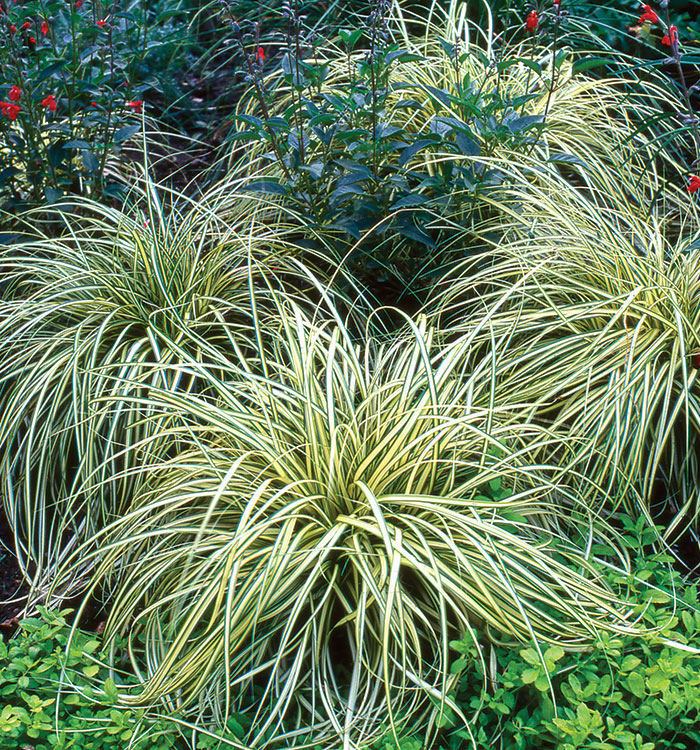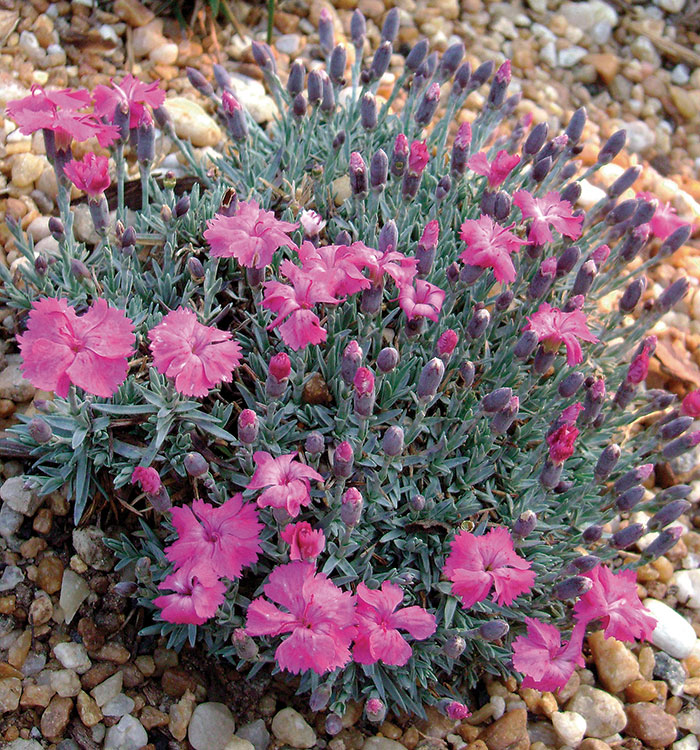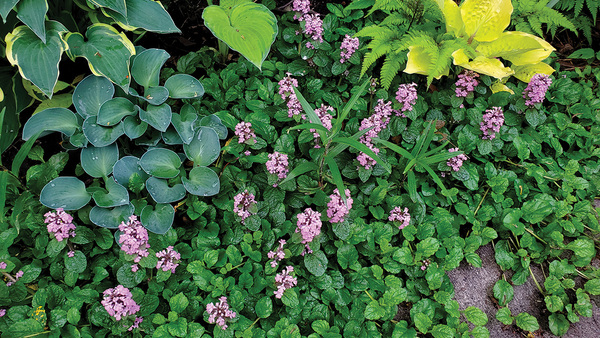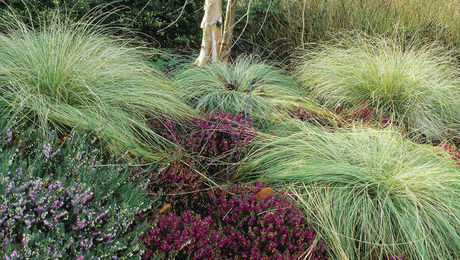
One garden cliché that drives me crazy is that ground covers are rambunctious troublemakers. The problem is that a few aggressive thugs give the entire lot a bad name. Most well-behaved ground covers don’t get the recognition they deserve. Maybe the reason nonthug ground covers are overlooked is because they are usually stepped on rather than grown as eye-level focal points. They may fade into the background, but their purpose is essential in a harmonious landscape. We need them for balance, texture, and depth; they even cool the soil, shade out weeds, and keep erosion at bay.
There is an abundance of polite low growers that will add color and interest to your garden. Some are touted as stand-alone plants, but when melded together in a mass, they have impact. With a little help from you, they will fill in as full as the most aggressive ground covers but without the threat of getting out of control.
Cover soggy soil with mounds of gold: ‘Evergold’ sedge

Name: Carex oshimensis ‘Evergold’, syn. C. hachijoensis ‘Evergold’
USDA Hardiness Zones: 6 to 9
Size: 1 foot tall and 14 inches wide
Conditions: Full sun to partial shade; fertile, moist, well-drained soil
‘Evergold’ has long, fine-textured golden leaves. In May, the foliage is covered with cute, fuzzy flowers, which look like caterpillars clinging to thin sticks. This clumping sedge is well behaved, so if you want full coverage, it’s best to plant it a bit tighter than you might think; I recommend placing them a foot apart. In late winter, cut back all the foliage to a few inches above the soil for a fresh, renewed display the following spring.
Help it spread: Separate clumps in spring by parting the plant at its base to see where it divides naturally, then breaking the roots apart using a spade. Plant divisions a foot apart.
A blanket of bright white blooms: ‘Snowflake’ candytuft

Name: Iberis sempervirens ‘Snowflake’
Zones: 5 to 9
Size: 10 inches tall and 2 feet wide
Conditions: Full sun; moist, well-drained soil; tolerates poor, dry soil
For us southerners who rarely see snow, it’s a treat to see candytuft’s snow white blooms carpet beds in spring and summer (in some regions, the plant is called snow in summer). I recommend planting it along paths because the white blooms glow in the moonlight and will naturally illuminate your walkway. Some candytufts get leggy, but ‘Snowflake’ boasts a tight form and a long bloom season. To keep the billowy form fresh and full, cut off the top half of the plant after the first show of spring blooms.
Help it spread: Use hairpins to tack down stems; they will quickly root, but expect the plant to take two years to reach maturity. Candytuft resents being transplanted but bounces back with time. I have not found division to be successful because of the plant’s woody roots.
Subtle shine for shady ground: Chinese giant wild ginger
Name: Asarum delavayi
Zones: 7 to 9
Size: 4 to 8 inches tall and 8 to 12 inches wide
Conditions: Partial to full shade; well-drained, moist, humus-rich soil
Colonies of the glossy, heart-shaped leaves of Chinese giant wild ginger look like clusters of mottled turtle shells. It grows, unfortunately, almost as slow as turtles move; however, this species is faster to establish than other gingers, taking about two years to reach maturity. In spring, it’s worth getting down on your hands and knees to glimpse the thick-fleshed, maroon-brown jug flowers at ground level. There is a spicy smell to the broken leaves, but don’t mistake this ginger for the edible one.
Help it spread: In spring, cut carefully between offsets at the thinnest part of the underground rhizome, and replant.
Clumps of color that are always welcome: ‘Blue Hills’ pink
Name: Dianthus ‘Blue Hills’
Zones: 2 to 9
Size: 4 to 6 inches tall and 8 to 12 inches wide
Conditions: Full sun; well-drained, average soil
Clumps of spiked foliage appeal to the punk in all of us. Compared to other cultivars, ‘Blue Hills’ boasts the bluest and densest foliage of all the pinks. The leaves are amped up in May with magenta flowers, and with faithful deadheading (because the deer don’t do it), mine bloom through summer. I plant pinks near my front door because they are not fazed by the lime that leaches into the soil from the construction mortar. Don’t forget to pull back the mulch to prevent crown rot: These sometimes-short-lived clumpers like it dry.
Help it spread: For the best results, take cuttings immediately after the first flush of flowers. Remove all but the top four sets of leaves on each stem cutting, dip each cut end in rooting hormone with fungicide, and plant them in pots. Cover the cuttings with plastic sandwich bags to maintain humidity. Transplant the rooted cuttings in spring.
You’ll never have to deadhead this one: ‘Biokovo’ mountain cranesbill

Name: Geranium × cantabrigiense ‘Biokovo’
Zones: 5 to 8
Size: 6 to 12 inches tall and 30 to 36 inches wide
Conditions: Full sun to partial shade; well-drained, rich soil
The perky, pale pink flowers of ‘Biokovo’ mountain cranesbill never have to be deadheaded. From May to July, the buds keep blooming and the runners keep spreading, creating a mat of rhizomes that restricts competition and weeds. In fall and winter, fragrant lobed leaves look like colorful confetti when old foliage turns bright red and orange in the midst of an evergreen carpet. Most pests, including deer, leave this drought-tolerant cranesbill alone.
Help it spread: In spring or fall, dig up underground rhizomes using a spade. Many of the rhizomes overlap but are not connected. Separate them by hand, and replant in the area you want to fill in.
Blazing color that refreshes hot, dry ground: Creeping shrubby ice plant
Name: Ruschia pulvinaris
Zones: 6 to 10
Size: 3 inches tall and 1 foot wide
Conditions: Full sun; well-drained, dry soil
This ice plant reminds me of deep-sea anemones. Stiff silver leaf tips perk up in the hottest sun; in late spring, electric pink flowers cover the foliage. The creeping habit forms dense waves over poor, dry soil and will add a vibrant spark of color to any planting. This ground cover will not fade into the background—it’s more of an exclamation point.
Help it spread: Propagate this clumping ice plant by cuttings. Simply pinch off a chunk, let the end air-dry until it forms a callus (which prevents rot), then plant.
Tresses of happy blooms for any bald spot: ‘White Delight’ moss pink

Name: Phlox subulata ‘White Delight’
Zones: 3 to 8
Size: 4 to 8 inches tall and 2 to 3 feet wide
Conditions: Full sun to partial shade; well-drained soil
When I see a bed of moss pink, I hear Bobby McFerrin singing “Don’t Worry, Be Happy.” ‘White Delight’ is my favorite because it holds up over winter better than other cultivars. The spreading, wiry stems casually hold clusters of flowers from April to May; to me, they resemble white dreadlocks. Once the flowers expire, cut the plant’s height back by half to encourage a second flush of white blooms. It looks great planted over retaining walls, where it can drape in its usual relaxed fashion. The deer even leave this care-free creeper alone. Moss pink is happy in just about any soil—even salty soil.
Help it spread: Moss pink has long ropelike stems that creep along and self-root where they contact the soil. To facilitate the process, pin a stem down and pile soil over the midpoint; in spring or fall, you can also snip off a stem and push it into moist soil. Division is another option; in fall, break up clumps using a spade or your hand, and place them in bare spots.
Reduce erosion with these blue-green blades: Mondo grass

Name: Ophiopogon japonicus
Zones: 7 to 10
Size: 8 to 12 inches tall and wide
Conditions: Full sun to full shade; average, well-drained soil
The straight species of mondo grass fills in more quickly without the center dieout of some specific cultivars. Pale purple to white flower spikes appear in June and July; they are followed by shiny, brilliant blue berries, which birds adore. Mondo grass looks great puddled around leggy shrubs or planted en masse to retain soil where erosion is a concern. You don’t need to mow this grass weekly; just shear tired foliage once a year in late winter.
Help it spread: Underground stolons spread on their own, so new tufts readily crop up. To speed up the natural process, divide mature clumps in spring or fall using a spade and pop the pups in bare spots.
It’s smart to divide
Division not only multiplies plants and helps them fill in fast but also rejuvenates plants that have decreased blooming, spindly growth, or dead clump centers. I’m frequently asked the following questions when it comes to dividing:
Q: Why should I divide on a cool, overcast day?
A: The plant will retain more moisture and experience less stress when it’s not exposed to direct sun and wind.
Q: How do I prepare my clump for division?
A: Before dividing, water the parent plant well. Remove any flower stalks to avoid sapping the plant’s energy, and cut off any dead material to prevent spreading disease. Also, cut the foliage back to reduce water loss and to prevent the chance of the plant toppling over because it is top-heavy.
Q: How can I keep the divided roots moist until I’m ready to transplant them?
A: Cover divided roots with a few layers of damp newspaper (below) and keep them out of direct sunlight to prevent them from drying out. If you can’t plant them until the following day, store them in a box surrounded by damp peat moss in a cool, dark location.

Q: What can I do to help my newly planted roots from drying out?
A: Dip divided roots into a thick slurry of clay (I use local clay, which is just heavy garden soil), and water just before replanting them. This promotes root-to-soil contact and reduces the hazard of air contacting the roots and drying them out.
Hilary Nichols is a former senior horticulturist at the Atlanta Botanical Garden and the current nursery and volunteer manager for EcoAddendum, native plant educators in Decatur, Georgia.
Photos, except where noted: Hilary Nichols.
Sources:
The following mail-order plant sellers offer the widest selection of the ground covers featured:
- Arrowhead Alpines, Fowlerville, Mich.; 517-223-3581; arrowheadalpines.com
- Sandy Mush Herb Nursery, Leicester, N.C.; 828-683-2014; sandymushherbs.com
- Tripple Brook Farm, Southampton, Mass.; 413-527-4626; tripplebrookfarm.com




















Comments
Log in or create an account to post a comment.
Sign up Log in